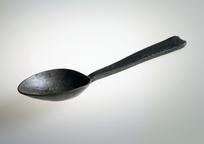











Silver finger ring, a memento mori in the form of a skull and cross bones with snakes intertwined
‘Memento mori’ translates from Latin as ‘Remember you must die’. This metal memento mori ring is in the form of a large skull and crossbones wedged between two snakes. The skull and crossbones is the traditional symbol of piracy, but also had other meanings. It suggested the ultimate triumph of death over life, for example Shakespeare’s famous scene in which Hamlet holds the skull of Yoric. Such rings were reminders of death. They prompted people about the shortness of life and the inevitability of death.
A skull was typically used to represent death from the 1500s onwards. It gradually replaced the common older image of a skeleton leading a living person off to their death.
Details
- Category:
- Wellcome (general)
- Collection:
- Sir Henry Wellcome's Museum Collection
- Object Number:
- A641706
- Materials:
- silver
- Measurements:
-
overall: 14 mm x 21 mm x 24 mm,
- type:
- ring - jewelry



